The SSD Relapse: Understanding and Choosing the Best SSD
by Anand Lal Shimpi on August 30, 2009 12:00 AM EST- Posted in
- Storage
Intel's X25-M 34nm vs 50nm: Not as Straight Forward As You'd Think
It took me a while to understand exactly what Intel did with its latest drive, mostly because there are no docs publicly available on either the flash used in the drives or on the controller itself. Intel is always purposefully vague about important details, leaving everything up to clever phrasing of questions and guesswork with tests and numbers before you truly uncover what's going on. But after weeks with the drive, I think I've got it.
| X25-M Gen 1 | X25-M Gen 2 | |
| Flash Manufacturing Process | 50nm | 34nm |
| Flash Read Latency | 85 µs | 65 µs |
| Flash Write Latency | 115 µs | 85 µs |
| Random 4KB Reads | Up to 35K IOPS | Up to 35K IOPS |
| Random 4KB Writes | Up to 3.3K IOPS | Up to 6.6K IOPS (80GB) Up to 8.6K IOPS (160GB) |
| Sequential Read | Up to 250MB/s | Up to 250MB/s |
| Sequential Write | Up to 70MB/s | Up to 70MB/s |
| Halogen-free | No | Yes |
| Introductory Price | $345 (80GB) $600 - $700 (160GB) | $225 (80GB) $440 (160GB) |
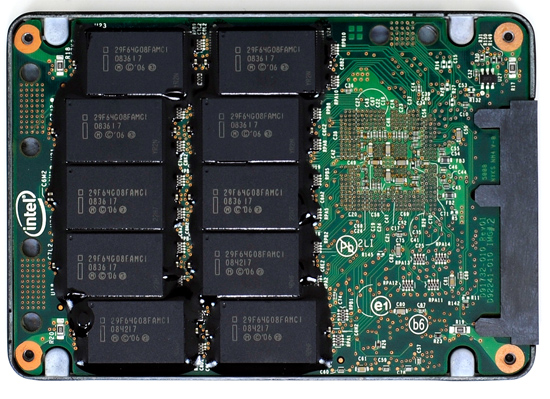
The old X25-M G1
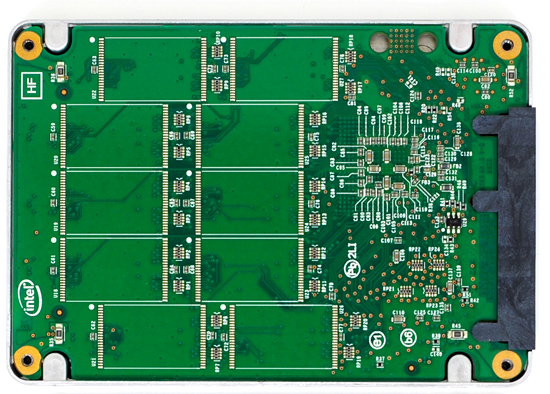
The new X25-M G2
Moving to 34nm flash let Intel drive the price of the X25-M to ultra competitive levels. It also gave Intel the opportunity to tune controller performance a bit. The architecture of the controller hasn't changed, but it is technically a different piece of silicon (that happens to be Halogen-free). What has changed is the firmware itself.

The old controller

The new controller
The new X25-M G2 has twice as much DRAM on-board as the previous drive. The old 160GB drive used a 16MB Samsung 166MHz SDRAM (CAS3):
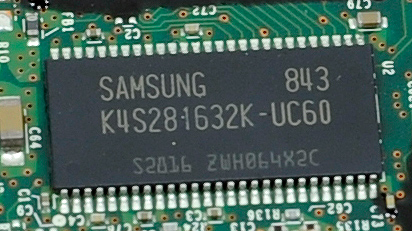
Goodbye Samsung
The new 160GB G2 drive uses a 32MB Micron 133MHz SDRAM (CAS3):
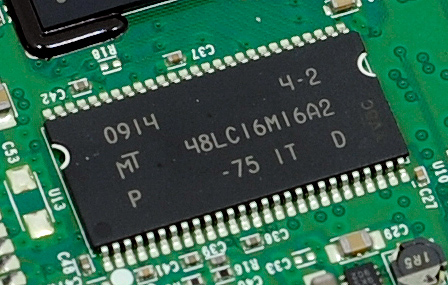
Hello Micron
More memory means that the drive can track more data and do a better job of keeping itself defragmented and well organized. We see this reflected in the "used" 4KB random write performance, which is around 50% higher than the previous drive.
Intel is now using 16GB flash packages instead of 8GB packages from the original drive. Once 34nm production really ramps up, Intel could outfit the back of the PCB with 10 more chips and deliver a 320GB drive. I wouldn't expect that anytime soon though.
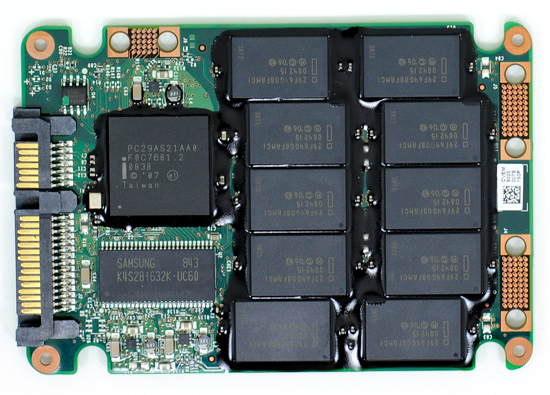
The old X25-M G1
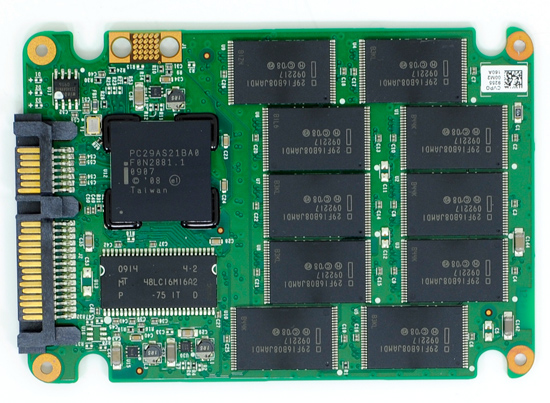
The new X25-M G2
Low level performance of the new drive ranges from no improvement to significant depending on the test:
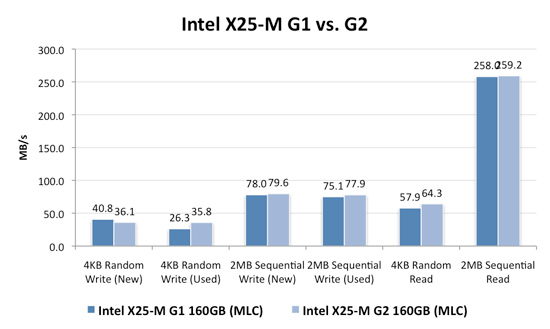
Note that these results are a bit different than my initial preview. I'm using the latest build of Iometer this time around, instead of the latest version from iometer.org. It does a better job filling the drives and produces more reliable test data in general.
The trend however is clear: the new G2 drive isn't that much faster. In fact, the G2 is slower than the G1 in my 4KB random write test when the drive is brand new. The benefit however is that the G2 doesn't drop in performance when used...at all. Yep, you read that right. In the most strenuous case for any SSD, the new G2 doesn't even break a sweat. That's...just...awesome.
The rest of the numbers are pretty much even, with the exception of 4KB random reads where the G2 is roughly 11% faster.
I continue to turn to PCMark Vantage as the closest indication to real world performance I can get for these SSDs, and it echoes my earlier sentiments:
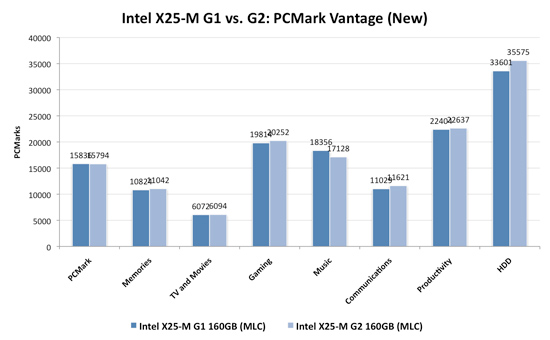
When brand new, the G1 and the G2 are very close in performance. There are some tests where the G2 is faster, others where the G1 is faster. The HDD suite shows the true potential of the G2 and even there we're only looking at a 5.6% performance gain.

It's in the used state that we see the G2 pull ahead a bit more, but still not drastic. The advantage in the HDD suite is around 7.5%, but the rest of the tests are very close. Obviously the major draw to the 34nm drives is their price, but that can't be all there is to it...can it?
The new drives come with TRIM support, albeit not out of the box. Sometime in Q4 of this year, Intel will offer a downloadable firmware that enables TRIM on only the 34nm drives. TRIM on these drives will perform much like TRIM does on the OCZ drives using Indilinx' manual TRIM tool - in other words, restoring performance to almost new.
Because it can more or less rely on being able to TRIM invalid data, the G2 firmware is noticeably different from what's used in the G1. In fact, if we slightly modify the way I tested in the Anthology I can actually get the G1 to outperform the G2 even in PCMark Vantage. In the Anthology, to test the used state of a drive I would first fill the drive then restore my test image onto it. The restore process helped to fragment the drive and make sure the spare-area got some use as well. If we take the same approach but instead of imaging the drive we perform a clean Windows install on it, we end up with a much more fragmented state; it's not a situation you should ever encounter since a fresh install of Windows should be performed on a clean, secure erased drive, but it does give me an excellent way to show exactly what I'm talking about with the G2:
| PCMark Vantage (New) | PCMark Vantage HDD (New) | PCMark Vantage (Fragmented + Used) | PCMark Vantage HDD (Fragmented + Used) | |
| Intel X25-M G1 | 15496 | 32365 | 14921 | 26271 |
| Intel X25-M G2 | 15925 | 33166 | 14622 | 24567 |
| G2 Advantage | 2.8% | 2.5% | -2.0% | -6.5% |
Something definitely changed with the way the G2 handles fragmentation, it doesn't deal with it as elegantly as the G1 did. I don't believe this is a step backwards though, Intel is clearly counting on TRIM to keep the drive from ever getting to the point that the G1 could get to. The tradeoff is most definitely performance and probably responsible for the G2's ability to maintain very high random write speeds even while used. I should mention that even without TRIM it's unlikely that the G2 will get to this performance state where it's actually slower than the G1; the test just helps to highlight that there are significant differences between the drives.
Overall the G2 is the better drive but it's support for TRIM that will ultimately ensure that. The G1 will degrade in performance over time, the G2 will only lose performance as you fill it with real data. I wonder what else Intel has decided to add to the new firmware...
I hate to say it but this is another example of Intel only delivering what it needs to in order to succeed. There's nothing that keeps the G1 from also having TRIM other than Intel being unwilling to invest the development time to make it happen. I'd be willing to assume that Intel already has TRIM working on the G1 internally and it simply chose not to validate the firmware for public release (an admittedly long process). But from Intel's perspective, why bother?
Even the G1, in its used state, is faster than the fastest Indilinx drive. In 4KB random writes the G1 is even faster than an SLC Indilinx drive. Intel doesn't need to touch the G1, the only thing faster than it is the G2. Still, I do wish that Intel would be generous to its loyal customers that shelled out $600 for the first X25-M. It just seems like the right thing to do. Sigh.










295 Comments
View All Comments
drsethl - Monday, March 15, 2010 - link
Hi,just to add to the chorus of praise: this is a superbly informative article, thank you for all the effort, and I hope that it has paid off for you, as I'm sure it must have.
My first question is this. Is it possible to analyse a program while you're using it, to see whether it is primarily doing sequential or random writes? Since there seems to be a quite clear difference between the Intel X25m 80gb and the OCZ vertex 120gb, which are the natural entry-level drives here, where the Intel works better for random access, the vertex for sequential, it would be very useful to know which I would make best use of.
Second question: does anyone know whether lightroom in particular is based around random or sequential writes? I know that a LR catalog is always radically fragmented, which suggests presumably that it is based around random writes, but that's just an uninformed guess. It does have a cache function, which produces files in the region of 3-5mb in size--are they likely to be sequential?
Third question: with photoshop, is it specifically as a scratch disk that the intel x25m underperforms? Or does photoshop do other sequential writes, besides those to the scratch disk? I ask because if it only doesn't work as a scratch disk, then that's not a big problem--anyone using this in a PC is likely to have a decent regular HDD for data anyway, so the scratch disk can just be sent there. In fact, I've been using a vertex 120gb, with a samsung spinpoint f3 500gb on my PC, and I found that with the scratch disk on the samsung I got better retouch artists results (only by about half a second, but that's out of 14 seconds, so still fairly significant).
Thanks in advance to anyone who might be able to answer, and thanks again Anand for such an informative read.
Cheers
Seth
drsethl - Friday, July 9, 2010 - link
Hi again,just to report back, since writing the previous comment I have bought both drives, vertex and intel (the original vertex 128gb, and the intel g2 x25m). While the Intel does perform better in benchmarks, the difference in general usage is barely noticeable. Except when using lightroom 3, when the intel is considerably slower than the vertex. I'm using a canon 550d, which produces 18mpx pictures. When viewing a catalogue for the first time (without any pre-created previews), the intel takes on average about 20s to produce a full scale 1:1 preview. This is infuriating. The vertex takes about 8s. Bear in mind that i've got 4gb of 1333mhz ram, intel i7 q720 processor, ati 5470 mobility radeon graphics. So it's not the most powerful laptop in the world, but it's no slouch either. I can only conclude that when LR3 makes previews it does large sequential writes, and that the considerable performance advantage of the vertex on this metric alone suddenly becomes very important. With which in mind, I'm now going to sell the Intel and buy a vertex 2e, which will give the best of both worlds. But I'm sure there are lots of photographers out there wondering about this like I was, so hopefully this will help.
cheers,
Seth
jgstew - Friday, October 8, 2010 - link
I believe you are correct about the LR Catalog being mostly random writes, but I don't think this is a performance concern since the Catalog is likely stored in RAM for reads, and written back to the drive when changes are made that affect the Catalog, which is not happening all the time.As for the generating previews and Photoshop scratch disk, this is going to be primarily sequential since it is generating the data one at a time and writing it to disk completely. If LR was generating multiple previews for multiple photos simultaneously and writing them simultaneously, then you would have heavy fragmentation of the cache, and more random writes.
Any SSD is going to give significant performance benefit over spindle HD when it comes to random read/write/access. Sequential performance is the man concern with Photos/Video/Audio and similar data in most cases.
One thing you might consider trying is having more than one SSD, or doing this if you upgrade down the road. Have the smaller SSD with fast sequential read/write act as the cache disk for LR/Photoshop/Others and have the other SSD be the boot drive with all the OS/Apps/etc. This way other things going on in the system will not effect the cache disk performance, as well as speed up writes from boot ssd to cache disk, and back.
ogreinside - Monday, December 14, 2009 - link
After spending all weekend reading this article, 2 previous in the trilogy, and all the comments, I wanted to post my thanks for all of your hard work. I've been ignoring SSDs for a while as I wanted to see them mature first. I am in the market for a new Alienware desktop, but as the wife is letting me purchase only on our Dell charge account, I have a limited selection and budget.I was settled on everything except the disks. They are offering the Samsung 256SSD, which I believe is the Samsung PM800 drive. The cost is exactly double that of the WD VelociRaptor 300 GB. So naturally I have done a ton of research for this final choice. After exploring your results here, and reading comments, I am definitely not getting their Samsung SSD. I would love to grab an Intel G2 or OCZ Indilinx, but that means real cash now, and we simply can't do that yet. The charge account gives us room to pay it off at 12-month no-interest.
So at this point I can get a 2x WD VR in raid 0 to hold me over for a year or so when I can replace (or add) a good SSD. My problem is that I have seen my share issues with raid 0 on an ICH controller on two different Dell machines (boot issues, unsure of performance gain). In fact, using the same drives/machine, I saw better random read performance (512K) on a single drive than the ICH raid, and 4k wasn't far behind. I'm thinking I may stick to a single WD VR for now, but I really want to believe raid0 would be better.
So, back on topic, it would be nice to see the ICH raid controller explored a bit, and maybe add a raid0 WD VR configuration to your next round of tests.
(CryastalDiskMark 2.2)
Single-drive 7200 rpm g:
Sequential Read : 123.326 MB/s
Sequential Write : 114.957 MB/s
Random Read 512KB : 55.793 MB/s
Random Write 512KB : 94.408 MB/s
Random Read 4KB : 0.861 MB/s
Random Write 4KB : 1.724 MB/s
Test Size : 100 MB
Date : 2009/12/09 2:03:4
ICH raid0:
Sequential Read : 218.909 MB/s
Sequential Write : 175.]347 MB/s
Random Read 512KB : 51.884 MB/s
Random Write 512KB : 135.466 MB/s
Random Read 4KB : 1.001 MB/s
Random Write 4KB : 2.868 MB/s
Test Size : 100 MB
Date : 2009/12/08 21:45:20
marraco - Friday, August 13, 2010 - link
Thumbs up for the ICH10 petition. It's the most common RAID controller on i7.Also, I would like to see different models of SSD in RAID (For example one intel raided with one Indilinx).
I suspect that performance with SSD scales much better that with older technologies. So I want to know if makes sense to buy a single SSD, and wait for prices to get cheaper at the time of upgrade. The problem is that as prices get cheaper, old SSD models are no more available.
aaphid - Friday, November 27, 2009 - link
OK, I'm still slightly confused. It seems that running the wipe/trim utility will keep the ssd in top condition but it won't run on a Mac. So are these going to be a poor decision for use in a Mac?ekerazha - Monday, October 26, 2009 - link
Anand,it's strange to see your
"Is Intel still my overall recommendation? Of course. The random write performance is simply too good to give up and it's only in very specific cases that the 80MB/s sequential write speed hurts you."
of the last review, is now a
"The write speed improvement that the Intel firmware brings to 160GB drives is nice but ultimately highlights a bigger issue: Intel's write speed is unacceptable in today's market."
ekerazha - Monday, October 26, 2009 - link
Ops wrong articlemohsh86 - Tuesday, October 13, 2009 - link
am 23 years old computer engineer..this is the most awesome informative article ever read !
Pehu - Tuesday, October 13, 2009 - link
First of all, thanks for the article. It was superb and led to my first SSD purchase last week. Installed the intel G2 yesterday and windows 7 (64 bit) with 8 G of RAM. A smooth ride I have to say :)Now, there is one question I have been trying to find an answer:
Should I put the windows page file (swap) to the SSD disk or to another normal HD?
Generally the swap should be behind other controller than your OS disk, to speed things up. However, SSD disks are so fast that there is a temptation to put the swap on OS disk. Also, one consideration is the disk age, does it preserve it longer if swap is moved away from SSD.
Also what I am lacking is some general info about how to maximise the disk age without too much loss of speed, in one guru3d article instructions were given as:
* Drive indexing disabled. (useless for SSD anyway, because access times are so low).
* Prefetch disabled.
* Superfetch disabled
* Defrag disabled.
Any comments and/or suggestions for windows 7 on that?
Thanks.